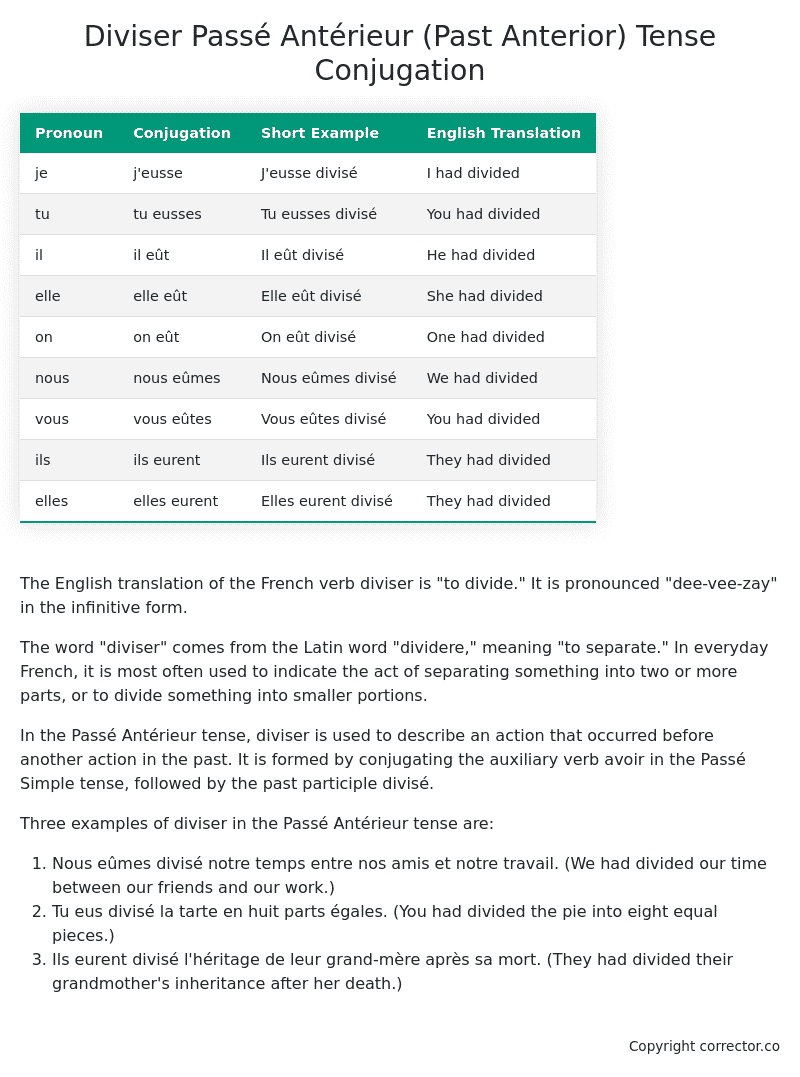Passé Antérieur (Past Anterior) Tense Conjugation of the French Verb diviser
Introduction to the verb diviser
The English translation of the French verb diviser is “to divide.” It is pronounced “dee-vee-zay” in the infinitive form.
The word “diviser” comes from the Latin word “dividere,” meaning “to separate.” In everyday French, it is most often used to indicate the act of separating something into two or more parts, or to divide something into smaller portions.
In the Passé Antérieur tense, diviser is used to describe an action that occurred before another action in the past. It is formed by conjugating the auxiliary verb avoir in the Passé Simple tense, followed by the past participle divisé.
Three examples of diviser in the Passé Antérieur tense are:
- Nous eûmes divisé notre temps entre nos amis et notre travail. (We had divided our time between our friends and our work.)
- Tu eus divisé la tarte en huit parts égales. (You had divided the pie into eight equal pieces.)
- Ils eurent divisé l’héritage de leur grand-mère après sa mort. (They had divided their grandmother’s inheritance after her death.)
Table of the Passé Antérieur (Past Anterior) Tense Conjugation of diviser
| Pronoun | Conjugation | Short Example | English Translation |
|---|---|---|---|
| je | j’eusse | J’eusse divisé | I had divided |
| tu | tu eusses | Tu eusses divisé | You had divided |
| il | il eût | Il eût divisé | He had divided |
| elle | elle eût | Elle eût divisé | She had divided |
| on | on eût | On eût divisé | One had divided |
| nous | nous eûmes | Nous eûmes divisé | We had divided |
| vous | vous eûtes | Vous eûtes divisé | You had divided |
| ils | ils eurent | Ils eurent divisé | They had divided |
| elles | elles eurent | Elles eurent divisé | They had divided |
Other Conjugations for Diviser.
Le Present (Present Tense) Conjugation of the French Verb diviser
Imparfait (Imperfect) Tense Conjugation of the French Verb diviser
Passé Simple (Simple Past) Tense Conjugation of the French Verb diviser
Passé Composé (Present Perfect) Tense Conjugation of the French Verb diviser
Futur Simple (Simple Future) Tense Conjugation of the French Verb diviser
Futur Proche (Near Future) Tense Conjugation of the French Verb diviser
Plus-que-parfait (Pluperfect) Tense Conjugation of the French Verb diviser
Passé Antérieur (Past Anterior) Tense Conjugation of the French Verb diviser (this article)
Futur Antérieur (Future Anterior) Tense Conjugation of the French Verb diviser
Subjonctif Présent (Subjunctive Present) Tense Conjugation of the French Verb diviser
Subjonctif Passé (Subjunctive Past) Tense Conjugation of the French Verb diviser
Subjonctif Imparfait (Subjunctive Imperfect) Tense Conjugation of the French Verb diviser
Subjonctif Plus-que-parfait (Subjunctive Pluperfect) Tense Conjugation of the French Verb diviser
Conditionnel Présent (Conditional Present) Tense Conjugation of the French Verb diviser
Conditionnel Passé (Conditional Past) Tense Conjugation of the French Verb diviser
L’impératif Présent (Imperative Present) Tense Conjugation of the French Verb diviser
L’infinitif Présent (Infinitive Present) Tense Conjugation of the French Verb diviser
Struggling with French verbs or the language in general? Why not use our free French Grammar Checker – no registration required!
Get a FREE Download Study Sheet of this Conjugation 🔥
Simply right click the image below, click “save image” and get your free reference for the diviser Passé Antérieur tense conjugation!

Diviser – About the French Passé Antérieur (Past Anterior) Tense
Formation of the Passé Antérieur
Common Usage Patterns
Literature
Historical Texts
Formal Writing
Interactions with Other Tenses
Passé Composé (Present Perfect)
Imparfait (Imperfect)
Futur Antérieur (Future Perfect)
Summary
I hope you enjoyed this article on the verb diviser. Still in a learning mood? Check out another TOTALLY random French verb conjugation!


